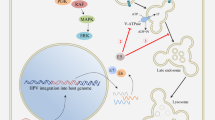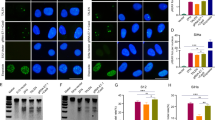Abstract
Cervical cancer is the second most common type of malignant tumor among women worldwide. When the disease is confined locally, it can be controlled with surgical resection and radiotherapy. However, patients with recurrent or metastatic disease often have a poor prognosis. Measurement of serum levels of squamous cell carcinoma (SCC) antigens has been widely used as serological markers for SCC of uterine cervix. Recently, it has been demonstrated that cervical cancer patients with elevated squamous cell carcinoma antigen-2 (SCCA2) expression in tumor cells carry a poor prognosis. Here, by using a luciferase reporter assay, we show that SCCA2 promoter was active in SCCA2-producing human cervical cancer cell lines, including Cx, Cxwj, SiHa and HeLa cells, but relatively quiescent in normal cervical epithelial cells. We then developed a conditionally replicating adenovirus, designated Ad-KFH, under the transcriptional control of the SCCA2 promoter. This E1B-55 kDa-deleted oncolytic adenovirus replicated specifically in and lysed SCCA2-producing cervical cancer cells. Furthermore, in a peritoneal metastatic tumor model, Ad-KFH retarded Cxwj tumor growth in NOD/severe combined immunodeficient mice and prolonged survival of tumor-bearing mice, especially when combined with cisplatin. These results suggest that Ad-KFH may provide a new strategy of gene therapy for advanced or recurrent uterine cervical cancer.
This is a preview of subscription content, access via your institution
Access options
Subscribe to this journal
Receive 12 print issues and online access
$259.00 per year
only $21.58 per issue
Buy this article
- Purchase on Springer Link
- Instant access to full article PDF
Prices may be subject to local taxes which are calculated during checkout




Similar content being viewed by others
References
Jemal A, Thomas A, Murray T, Thun M . Cancer statistics, 2002. CA Cancer J Clin 2002; 52: 23–47.
Wright TC, Ferenczy A, Kurman RJ . Carcinoma and other tumors of cervix. In: Kurman RJ (ed). Blaustein's Pathology of the Female Genital Tract, 5th edn. Springer-Verlag: New York, NY, 2002, pp 325–381.
Kato H, Torigoe T . Radioimmunoassay for tumor antigen of human cervical squamous cell carcinoma. Cancer 1977; 40: 1621–1628.
Duk JM, Groenier KH, de Bruijn HW, Hollema H, ten Hoor KA, van der Zee AG et al. Pretreatment serum squamous cell carcinoma antigen: a newly identified prognostic factor in early-stage cervical carcinoma. J Clin Oncol 1996; 14: 111–118.
Chou CY, Wang ST, Kuo HC, Tzeng CC, Yao BL . Serum level of squamous cell carcinoma antigen and tumor size are useful to identify preoperatively patients at high risk of cervical cancer. Cancer 1994; 74: 2497–2501.
Bolli JA, Doering DL, Bosscher JR, Day Jr TG, Rao CV, Owens K et al. Squamous cell carcinoma antigen: clinical utility in squamous cell carcinoma of the uterine cervix. Gynecol Oncol 1994; 55: 169–173.
Pras E, Willemse PH, Canrinus AA, de Bruijn HW, Sluiter WJ, ten Hoor KA et al. Serum squamous cell carcinoma antigen and CYFRA 21-1 in cervical cancer treatment. Int J Radiat Oncol Biol Phys 2002; 52: 23–32.
Vassilakopoulos T, Troupis T, Sotiropoulou C, Zacharatos P, Katsaounou P, Parthenis D et al. Diagnostic and prognostic significance of squamous cell carcinoma antigen in nonsmall cell lung cancer. Lung Cancer 2001; 32: 137–144.
Snyderman CH, D’Amico F, Wagner R, Eibling DE . A reappraisal of the squamous cell carcinoma antigen as a tumor marker in head and neck cancer. Arch Otolaryngol Head Neck Surg 1995; 121: 1294–1297.
Shimada H, Nabeya Y, Okazumi S, Matsubara H, Shiratori T, Gunji Y et al. Prediction of survival with squamous cell carcinoma antigen in patients with resectable esophageal squamous cell carcinoma. Surgery 2003; 133: 486–494.
Molina R, Filella X, Torres MD, Ballesta AM, Mengual P, Cases A et al. SCC antigen measured in malignant and nonmalignant diseases. Clin Chem 1990; 36: 251–254.
Suminami Y, Kishi F, Sekiguchi K, Kato H . Squamous cell carcinoma antigen is a new member of the serine protease inhibitors. Biochem Biophys Res Commun 1991; 181: 51–58.
Schneider SS, Schick C, Fish KE, Miller E, Pena JC, Treter SD et al. A serine proteinase inhibitor locus at 18q213 contains a tandem duplication of the human squamous cell carcinoma antigen gene. Proc Natl Acad Sci USA 1995; 92: 3147–3151.
Schick C, Bromme D, Bartuski AJ, Uemura Y, Schechter NM, Silverman GA . The reactive site loop of the serpin SCCA1 is essential for cysteine proteinase inhibition. Proc Natl Acad Sci USA 1998; 95: 13465–13470.
Luke C, Schick C, Tsu C, Whisstock JC, Irving JA, Bromme D et al. Simple modifications of the serpin reactive site loop convert SCCA2 into a cysteine proteinase inhibitor: a critical role for the P3′ proline in facilitating RSL cleavage. Biochemistry 2000; 39: 7081–7091.
Bae SM, Lee CH, Cho YL, Nam KH, Kim YW, Kim CK et al. Two-dimensional gel analysis of protein expression profile in squamous cervical cancer patients. Gynecol Oncol 2005; 99: 26–35.
Hsu KF, Huang SC, Shiau AL, Cheng YM, Shen MR, Chen YF et al. Increased expression level of squamous cell carcinoma antigen 2 and 1 ratio is associated with poor prognosis in early-stage uterine cervical cancer. Int J Gynecol Cancer 2007; 17: 174–181.
Khuri FR, Nemunaitis J, Ganly I, Arseneau J, Tannock IF, Romel L et al. A controlled trial of intratumoral ONYX-015, a selectively-replicating adenovirus, in combination with cisplatin and 5-fluorouracil in patients with recurrent head and neck cancer. Nat Med 2000; 6: 879–885.
Bischoff JR, Kirn DH, Williams A, Heise C, Horn S, Muna M et al. An adenovirus mutant that replicates selectively in p53-deficient human tumor cells. Science 1996; 274: 373–376.
Chou CY, Chen YH, Tzeng CC, Cheng YC, Chang CF, Chen TM . Establishment and characterization of a human-papillomavirus negative, p53-mutation negative human cervical cancer cell line. Cancer Let 1996; 102: 173–181.
Chou CY, Shen MR, Wu SN . Volume-sensitive chloride channels associated with human cervical carcinogenesis. Cancer Res 1995; 55: 6077–6083.
Halbert CL, Demers GW, Galloway DA . The E7 gene of human papillomavirus type 16 is sufficient for immortalization of human epithelial cells. J Virol 1991; 65: 473–478.
Hamada K, Hanakawa Y, Hashimoto K, Iwamoto M, Kihana T, Hirose S et al. Gene expression of human squamous cell carcinoma antigens 1 and 2 in human cell lines. Oncol Rep 2001; 8: 347–354.
Sakaguchi Y, Kishi F, Murakami A, Suminami Y, Kato H . Structural analysis of human SCC antigen 2 promoter. Biochim Biophys Acta 1999; 1444: 111–116.
Hsieh JL, Wu CL, Lee CH, Shiau AL . Hepatitis B virus X protein sensitizes hepatocellular carcinoma cells to cytolysis induced by E1B-deleted adenovirus through the disruption of p53 function. Clin Cancer Res 2003; 9: 338–345.
He TC, Zhou S, da Costa LT, Yu J, Kinzler KW, Vogelstein B . A simplified system for generating recombinant adenoviruses. Proc Natl Acad Sci USA 1998; 95: 2509–2514.
Shieh GS, Shiau AL, Yo YT, Lin PR, Chang CC, Tzai TS et al. Low-dose etoposide enhances telomerase-dependent adenovirus-mediated cytosine deaminase gene therapy through augmentation of adenoviral infection and transgene expression in a syngeneic bladder tumor model. Cancer Res 2006; 66: 9957–9966.
Wu CL, Shieh GS, Chang CC, Yo YT, Su CH, Chang MY et al. Tumor-selective replication of an oncolytic adenovirus carrying Oct-3/4 response elements in murine metastatic bladder cancer models. Clin Cancer Res 2008; 14: 1228–1238.
Freytag SO, Rogulski KR, Paielli DL, Gilbert JD, Kim JH . A novel three-pronged approach to kill cancer cells selectively: concomitant viral, double suicide gene, and radiotherapy. Hum Gene Ther 1998; 9: 1323–1333.
Oshikiri T, Miyamoto M, Hiraoka K, Shichinohe T, Kawarada Y, Kato K et al. Transcriptional targeting of adenovirus vectors with the squamous cell carcinoma-specific antigen-2 promoter for selective apoptosis induction in lung cancer. Cancer Gene Ther 2006; 13: 856–863.
Hamada K, Shinomiya H, Asano Y, Kihana T, Iwamoto M, Hanakawa Y et al. Molecular cloning of human squamous cell carcinoma antigen 1 gene and characterization of its promoter. Biochim Biophys Acta 2001; 1518: 124–131.
Heise C, Kirn D . Replication-selective adenoviruses as oncolytic agents. J Clin Invest 2000; 105: 847–851.
Walboomers JM, Jacobs MV, Manos MM, Bosch FX, Kummer JA, Shah KV et al. Human papillomavirus is a necessary cause of invasive cervical cancer worldwide. J Pathol 1999; 189: 12–19.
Steinwaerder DS, Carlson CA, Lieber A . Human papilloma virus E6 and E7 proteins support DNA replication of adenoviruses deleted for the E1A and E1B genes. Mol Ther 2001; 4: 211–216.
Moore DH . Chemotherapy for recurrent cervical carcinoma. Curr Opin Oncol 2006; 18: 516–519.
Vollmer CM, Ribas A, Butterfield LH, Dissette VB, Andrews KJ, Eilber FC et al. p53 selective and nonselective replication of an E1B-deleted adenovirus in hepatocellular carcinoma. Cancer Res 1999; 59: 4369–4374.
Heise C, Lemmon M, Kirn D . Efficacy with a replication selective adenovirus plus cisplatin-based chemotherapy: dependence on sequencing but not p53 functional status or route of administration. Clin Cancer Res 2000; 6: 4908–4914.
Kirn D . Clinical research results with dl1520 (Onyx-015), a replication- selective adenovirus for the treatment of cancer: what have we learned? Gene Ther 2001; 8: 89–98.
Sanchez-Prieto R, Quintanilla M, Cano A, Leonart ML, Martin P, Anaya A et al. Carcinoma cell lines become sensitive to DNA-damaging agents by the expression of the adenovirus E1A gene. Oncogene 1996; 13: 1083–1092.
Acknowledgements
We are indebted to Dr TC Wu (Department of Pathology, Johns Hopkins University, USA) for providing retroviral vector LXSN expressing HPV type 16 E6 and E7. This work was supported by grants from the National Science Council (NSC 93-2314-B-006-074 and NSC 94-2314-B-384-010) and Center of Excellence for Clinical Trial and Research in Oncology Specialty, Ministry of Health, Taiwan.
Author information
Authors and Affiliations
Corresponding authors
Rights and permissions
About this article
Cite this article
Hsu, KF., Wu, CL., Huang, SC. et al. Conditionally replicating E1B-deleted adenovirus driven by the squamous cell carcinoma antigen 2 promoter for uterine cervical cancer therapy. Cancer Gene Ther 15, 526–534 (2008). https://doi.org/10.1038/cgt.2008.37
Received:
Revised:
Accepted:
Published:
Issue Date:
DOI: https://doi.org/10.1038/cgt.2008.37
Keywords
This article is cited by
-
A Solanum incanum extract (SR-T100) regresses vulvar condyloma acuminatum and induces distinct autophagic and apoptotic responses in different types of HPV-infected cells
Translational Medicine Communications (2017)
-
Site-directed mutagenesis of human papillomavirus 18 promoter elements and tissue-specific expression in cervical carcinoma cells
Virus Genes (2012)
-
Intelligent Design: Combination Therapy With Oncolytic Viruses
Molecular Therapy (2010)
-
Oncolytic adenovirus mediated Survivin knockdown by RNA interference suppresses human colorectal carcinoma growth in vitro and in vivo
Journal of Experimental & Clinical Cancer Research (2009)



